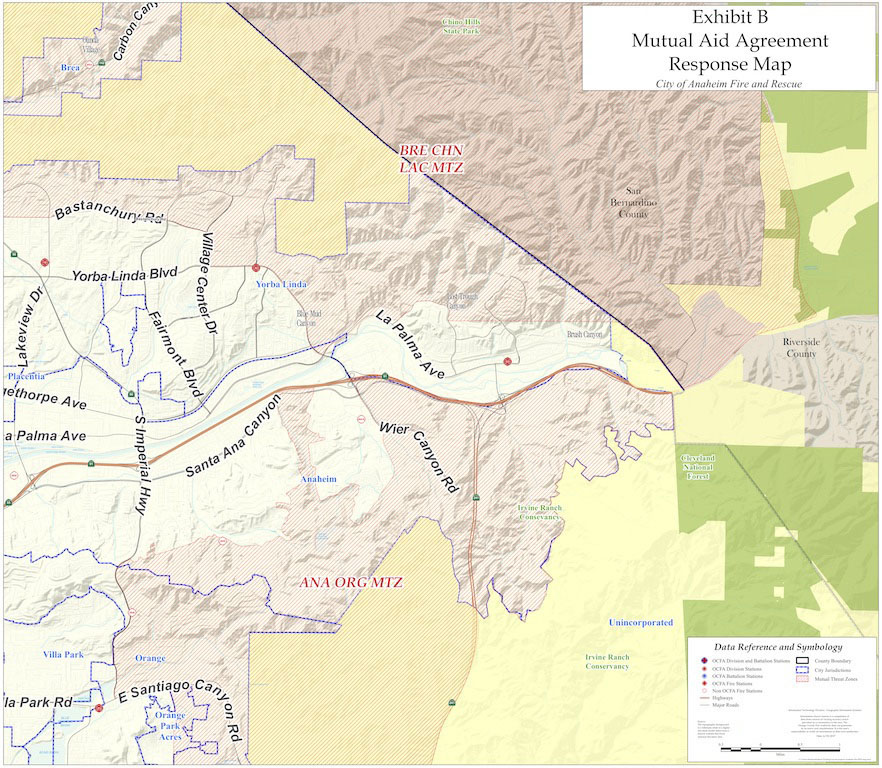As one of the top wildland fire experts in the country, Anaheim Fire & Rescue Deputy Chief Pat Russell sees a lot of action during the fire season.
And as an operation sections chief on a federal Type 1 incident management team — a unit that handles the most complex wildfires — Russell can be sent all over the country when nothing major is happening in Anaheim.
And so it went this summer, when Russell’s incident management team was dispatched to wildfires in Arizona, New Mexico, Santa Barbara, Oregon and Northern California.
Then, in late September and October, Russell got very busy back home.
The Canyon Fire 1 and Canyon Fire 2 fires erupted, with the latter, more destructive fire ending up burning more than 9,200 acres and destroying or damaging about 60 homes around Anaheim Hills.
Russell served as an operations chief on Canyon Fire 1, and as incident commander on Canyon Fire 2.
And because of a proposal he made six years ago to AF&R Chief Randy Bruegman, those blazes were much less costly to the City of Anaheim than they otherwise would have been.
Russell proposed that Anaheim Fire & Rescue enter a Wildland Fire Protection Agreement with the California Department of Forestry and Fire Protection (Cal Fire) — something other agencies, including Chino, previously had done.
Bruegman approved the idea, and the agency officially entered into a Cal Fire Local Area Wildland Fire Protection Agreement in July of 2013.
The agreement guarantees a response from Cal Fire when wildfires erupt in Anaheim’s so-called LRA, for Local Responsibility Area — wildland that is the responsibility of AF&R to protect. In the case of Canyon Fire 2, which began Oct. 9 and was declared 100 percent contained Oct. 17, around 2,600 acres of land fell within the contracted area with Cal Fire, Russell said.
That meant that at no extra cost to Anaheim, Cal Fire sent dozens of engines, several hand crews and dozers, and multiple aircraft to help fight the blaze.
If AF&R had not had in place a Cal Fire Local Area Wildland Fire Protection Agreement, Cal Fire later would have billed the city for such a response — at a cost that likely would have ballooned into hundreds of thousands of dollars, Russell said.
For example, a single drop of retardant from a Cal Fire fixed-wing aircraft can cost between $15,000 and $20,000.
“You could run up a huge bill,” Russell said. “That would be very easy to do.”
Anaheim pays Cal Fire annually for the contract, said Russell, who runs AF&R’s Operations Division, AF&R’s largest division.
“The best way to think of it is, it’s basically an insurance policy,” Russell said of the Cal Fire Local Area Wildland Fire Protection Agreement. “It’s a very beneficial contract.
“We’ve had (Cal Fire) responses to several fires every year since we’ve had the contract in place, so it has more than paid for itself.”

Anaheim Fire & Rescue Deputy Chief Pat Russell: “We’ve had (Cal Fire) responses to several fires every year since we’ve had the contract in place, so it has more than paid for itself.”
Photo by Steven Georges/Behind the Badge OC
Anaheim is one of 15 cities and agencies statewide that have Wildland Fire Protection Agreements with Cal Fire. The others are Auburn, Chino, the Chino Valley Independent Fire Department, Colton, Jurupa Valley, Lake Elsinore, Loma Linda, Menifee, Murrieta, Redlands, Rocklin, Tiburon, Truckee and Wildomar.
And with 4,500 acres covered by the agreement (most of it south of the 91 Freeway), and an additional 3,000 acres scheduled to be added soon, Anaheim is among tops in the state in terms of acreage covered under the Wildland Fire Protection Agreement.
At AF&R, Russell is in charge of seven battalion chiefs and about 200 fire suppression personnel who handle about 30,000 emergency incidents a year for fires, rescues, medical aid and other calls for service.
He has no doubt that the contract with Cal Fire will reap dividends moving forward.
“That’s a prominent fire corridor in Orange County,” Russell said of the land burned by Canyon Fire 1 and Canyon Fire 2. “In eight to 10 years, it will be ready to burn again.”
 Behind the Badge
Behind the Badge




